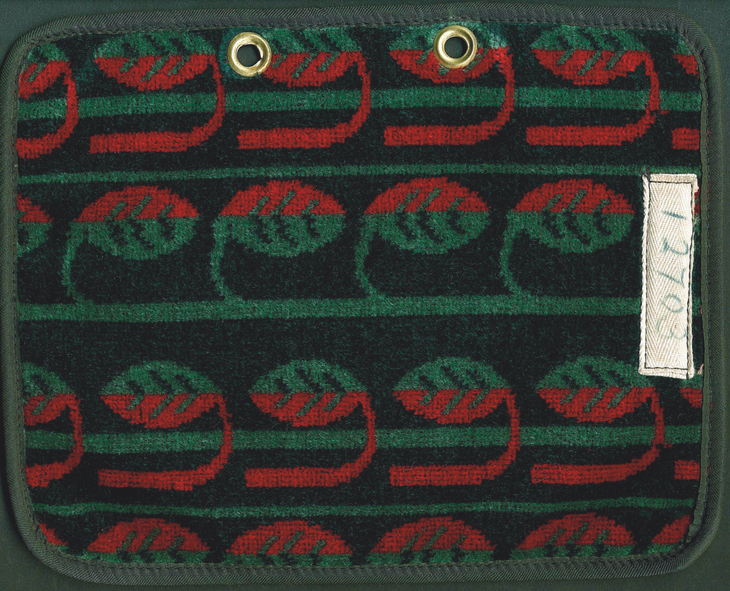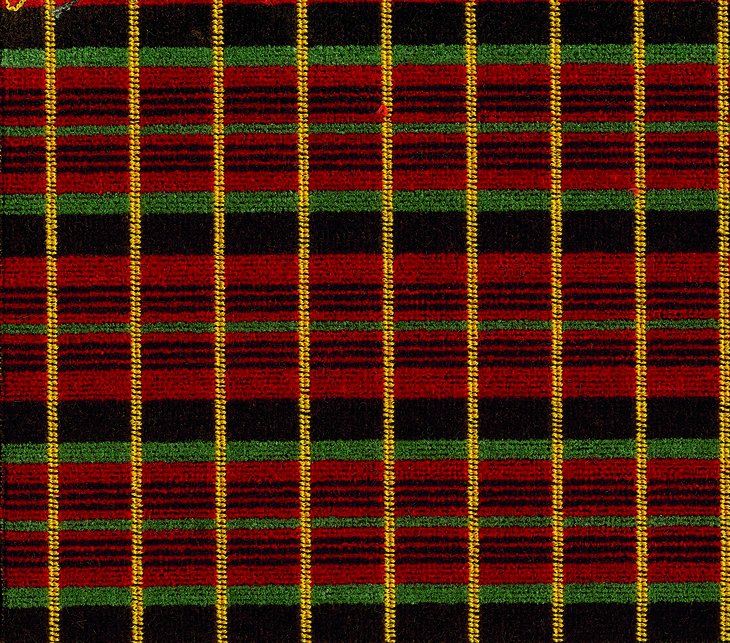
You may know your Barman from your Overground moquette. But London's trains, buses and trams have a far deeper history of woven seat fabric.
A new book, Seats of London, explores London's relationship with the artworks that millions of us sit on every day. Here are 13 designs you may not know.
1. The first moquette?

It's difficult to pinpoint the 'first' moquette on London transport. In the early days, the Metropolitan line ran many different trains, with three classes of accommodation, and seating was varied. By 1898, however, we know moquette was a thing on the Underground; that's when The Engineer magazine reviewed the first-class seating on a carriage, noting its 'figured rose-coloured Baghdad moquette finished with silk lace and cord.' (Very posh.)
The moquette from above is from a 1925 refit of those carriages. It's a rougher texture than Londoners' backsides are used to now, but a charming enough pattern — and an indicator of the geometric styles to come.

2. The floral moquette

Not all moquettes were geometric though. Other early designs were more outwardly inspired by nature — such as this one, which you'd find on a Diddler trolleybus between the 1930s and 60s. (The Diddler was so-called because it 'diddled about'.) The pattern looks rather drab now, but in its pre-faded days, would have presented a brighter foliage, with a decidedly homey vibe.
3. The leafy moquette

It does seem strange that nature's always been an inspiration for this grittily urban transport system. Maybe it has something to do with subconsciously relaxing passengers. Anyway, this moquette, commissioned by Christian Barman (yes, THAT Barman) in 1938, is a marvellous melding of the geometric and Mother Nature. It's actually called Colindale, but was more often referred to as leaf, because... yeah, that.
4. The double diamond moquette (nothing to do with bad beer)

The London train companies employed female designers from pretty early on — both for poster art, and for upholstery. This 'double diamond' design from the mid-1930s was the work of Enid Marx. The House of Illustration in King's Cross had a retrospective of her work in 2018.
5. The moquette designed by a war artist

In Seats of London, author Andrew Martin says that the 'muddy places' of Paul Nash's war art are subsumed in this abstract moquette. It's certainly got an earthy quality. Sadly, although it's thought this design, called Alperton, was the first ever to be specially commissioned by London Underground (in 1928), it never appeared in a train carriage.
6. The moquette which decked out the Rolls-Royce of trolleybuses

The last trolleybus service to run from Uxbridge to Hanwell Broadway, on 8 November 1960, was fitted out in this abstract moquette design. The QI Class was described as the Rolls-Royce of trolleybuses, although that didn't stop it being decommissioned altogether in 1962. The above design certainly isn't the Rolls-Royce of moquettes. We might even hate it a bit.
7. The moquette with the best logo of all time

It stands to reason that one of the all-time iconic symbols should appear on a moquette design. And nicely done it is, too in the design known as Roundel or Bullseye. According to Seats of London, it was believed for a long time that Eddie Chapman, head designer at the moquette manufacturers Holdsworth's, was behind this. Later evidence suggests it was the brainchild of Miss Jarvis, 'a very young and new designer' from the same company.
8. The moquette inspired by a fossil

More of the same lustrous reds and greens going on in this moquette, first previewed in 1958. It's called Fossil, and is inspired by trilobites — fossils of a spiral- shelled snail that died out 250 million years ago. You can see this moquette in the London Transport Museum, in a Metropolitan bogie stock carriage from 1900.
9. The moquette they should have used on the Mail Rail

This smart-looking weave was described by moquette magnate David Holdsworth as "a silver backing with black, and just a spot of Post Office red." It's said it was his favourite moquette. It was rolled out in 1959/60 on Metropolitan line's new A-Stock. We think it'd make a smashing hand towel.
10. The moquette that lives on in socks

You may well be acquainted with this rich, gold-threaded tartan, which first appeared on Routemaster buses in 1959. The colour scheme was officially 'burgundy lining panels, Chinese green window surrounds and Sung yellow ceilings'. You may, like us, own a pair of socks with the same design.
11. Another diamond moquette

The Metropolitan line rebelled against Frank Pick's early plans for the round roundel, going instead with diamond shaped signs, denoting the Underground station. This moquette (designer unknown) is probably a reference to the Met line's obstinacy — even though it wasn't rolled out till the 1990s, when the diamonds were well and truly out.
12. The original Crossrail moquette

That's right, the first Crossrail moquette was created back in the 1980s, for the never to be seen Class 341 Crossrail trains. The pattern's called Crossrail Aero, and its designer, Jonathan Sothcott, recalls it reluctantly: "It reminds me of a shell suit," he admits.
13. The blindingly corporate moquette

Before the internet, there was Yellow Pages. And Yellow Pages patently had some cash, too, because their 1995-2001 campaign involved not only pasting over double-deckers with full ads, but fitting out tube stock with Yellow Pages moquette. Andrew Martin reckons there are only two other instances of this: a fuchsia pink design to herald the digital switchover, and a red moquette on the Waterloo & City line, plugging the Rugby World Cup.


Seats of London, A Field Guide to London Transport Moquette Patterns by Andrew Martin, (Safe Haven Books), RRP £12.99. (buying via this link will help support our site with a small commission)
Also available from London Transport Museum




